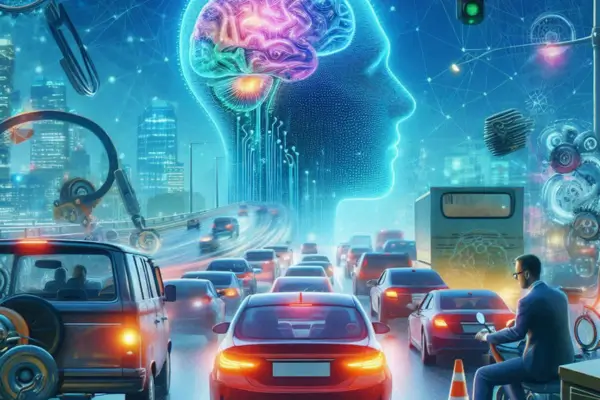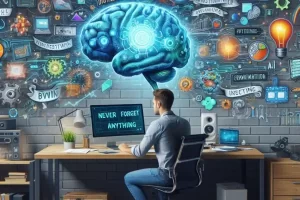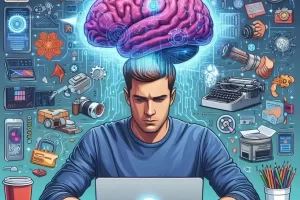We live in a world of nonstop information. Articles, podcasts, online courses, PDFs, webinars — it’s endless. But most of it gets consumed and forgotten. That’s why building a knowledge management system inside your second brain is critical. And when you add artificial intelligence (AI), that system becomes smarter, faster, and more valuable over time.
In this article, you’ll learn how to create an AI-enhanced knowledge management system that turns information overload into clarity, insight, and action.
Why You Need a Knowledge Management System (KMS)
A KMS isn’t just about collecting more content. It’s about:
- Curating the best ideas
- Structuring your learning
- Finding things when you need them
- Applying what you’ve already learned
- Connecting knowledge across time and context
Without a system:
- You save articles and never read them
- You forget insights from books or courses
- You redo research you already did
- You miss patterns hiding in your notes
Your second brain — especially when powered by AI — prevents this. It helps you store knowledge, access it, and grow from it.
Define Your Knowledge Pillars
Start by identifying the main themes or domains of knowledge you want to manage.
Examples:
- 🧠 Psychology
- 📈 Marketing
- 💡 Innovation
- 🗣 Communication
- 🧘 Wellness
- 🛠 Productivity
- 📚 Learning strategies
- 🧭 Decision-making
These are your knowledge categories. Everything you collect should fall into one or more of them.
Ask AI:
“Based on my last 20 notes, what are the recurring topics I study?”
“Suggest 10 knowledge areas to focus on, based on my career and interests.”
Build a Knowledge Vault
Create a central space in your second brain where all knowledge lives.
For each note or resource, include:
- 📄 Title or topic
- 📌 Source (book, podcast, course, etc.)
- 🧠 Summary or key ideas
- 🏷 Tags or linked concepts
- 🔁 Review date (optional)
- 🗂 Application ideas
You can build this in Notion (database), Obsidian (markdown files + backlinks), or Tana (node-based structure).
AI can help you:
“Summarize this article in 3 bullet points.”
“Extract the most important quote from this podcast transcript.”
“Tag this note based on its topic and use case.”
Use AI to Turn Raw Notes Into Structured Insights
One of the biggest challenges is turning messy inputs into clear, useful ideas.
AI helps by:
- Cleaning up highlights
- Summarizing long-form content
- Converting notes into actionable lessons
- Creating evergreen knowledge from raw input
Prompts:
“Summarize this book chapter in 5 key ideas.”
“Turn this voice memo into a structured note with title and tags.”
“What are 3 real-world applications of this insight?”
Now your notes become knowledge assets.
Link Related Notes and Concepts
Your KMS becomes more valuable when ideas connect across time and categories.
Use AI to:
- Suggest related notes
- Group similar ideas
- Build internal links and relationships
- Create a map of your knowledge graph
Examples:
“What other notes in my second brain relate to habit formation?”
“Find all entries that mention ‘deep work’ or ‘focus’.”
“Cluster my notes into 5 themes based on content overlap.”
This builds contextual awareness into your system.
Create a Learning Workflow
Build a routine for how knowledge enters and flows through your second brain.
A simple workflow:
- Capture → Highlight, clip, record
- Process → Summarize and organize with AI
- Store → Add to vault with tags and links
- Review → Revisit with spaced repetition or weekly review
- Apply → Use in content, projects, or decision-making
Let AI automate parts:
- “Every Friday, summarize new notes and suggest what to review.”
- “Based on recent content, what should I revisit next week?”
- “Suggest 3 ways to use this idea in a new project.”
Build Evergreen Notes
Evergreen notes are permanent, evolving entries that hold timeless insights.
Each one should include:
- A clear explanation of the concept in your words
- Examples or stories
- Links to related ideas
- Updates as your understanding evolves
Use AI to:
“Turn this messy note into an evergreen concept page.”
“What’s missing from this note to make it more complete?”
“How can I simplify this idea for a beginner?”
Over time, you build your own personal Wikipedia.
Track and Review Your Knowledge Growth
Add a review system to reflect on how your knowledge is expanding.
Use AI to help:
- “Summarize what I’ve learned about marketing in the past 90 days.”
- “What are the top 5 insights I’ve captured this month?”
- “Which areas of my KMS are underdeveloped?”
- “What ideas have I collected but never used?”
This helps you close the loop — from collecting to learning to applying.
Real-Life Example: Knowledge Management for a Consultant
Let’s say you’re a business consultant:
- You store notes from client calls, market research, and strategy books
- AI summarizes insights from meetings and organizes them by theme
- You review your notes weekly to prepare for presentations
- AI suggests which case studies to reference for each client
- Your evergreen notes form the base of training programs and articles
You don’t waste time searching. You spend your time thinking, deciding, and creating.
Final Thoughts: Make Your Knowledge Work for You
Knowledge is only power if you can find it, trust it, and use it.
With a second brain and AI:
- You build a system that captures what matters
- You process ideas faster and with more structure
- You connect your thinking across time and topics
- You become more strategic, creative, and informed
Don’t just collect information. Build your personal knowledge engine — and let it guide your growth.




